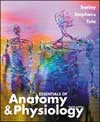 |  Essentials of Anatomy & Physiology, 4/e Rod R. Seeley,
Idaho State University
Philip Tate,
Phoenix College
Trent D. Stephens,
Idaho State University
Blood Vessels and Circulation
Study OutlineFunctions of the Peripheral Circulation
Carry blood
Exchange nutrients and gas
Transport hormones
Regulate blood pressureClinical Focus: Circulatory Shockp. 369
Direct blood flow
General Features of Blood Vessel Structure
Vessel walls(Fig. 13.1, p. 343)Tunica intima
Tunica media
Tunica adventitia (externa) Types of vessels
Systemic v. Pulmonary vessels
Arteries(Fig. 13.1, p. 343)Elastic arteries and elastic recoil
Muscular arteries
Distributing (medium-sized) arteries(Fig. 13.2, p. 344)Small diameter arteries
Vasoconstriction
Arterioles(Fig. 13.1, p. 343) Capillaries(Fig. 13.3, 13.4, p. 344)Veins(Fig. 13.1, p. 343)Venules and small veins
Medium-sized veins
Large veins
Valves
Aging of arteries
Arteriosclerosis
Atherosclerosis(Fig. 13.5, p. 345) Blood Vessels of the Pulmonary Circulation(Fig. 13.6, p. 346)Pulmonary trunk & arteries from Rt. ventricle
Pulmonary veins to Lft. atrium
Blood Vessels of the Systemic Circulation: Arteries(Fig. 13.6, p. 346,
Fig. 13.7, p. 347)Aorta(Fig. 13.8, p. 348)Ascending aorta and coronary arteries
Aortic arch
Descending aorta
Thoracic aorta
Abdominal aorta
Termination in common iliac arteries Arteries of the head and neck(Fig. 13.9, p. 349, Tbl. 13.1, p. 350)Brachiocephalic artery
Right common carotid artery
Right internal carotid artery
Right external carotid artery
Right subclavian artery
Right vertebral artery
Left common carotid artery
Left internal carotid artery
Left external carotid artery
Left subclavian artery
Left vertebral artery
Arteries supplying the brain (Fig. 13.9, p. 349, Tbl. 13.1, p. 350)Internal carotid arteries
Vertebral arteries
Circle of Willis
Arteries of the upper limbs (Fig. 13.7, p. 347, Tbl. 13.1, p. 350)Subclavian arteries
Axillary arteries
Brachial arteries
Radial and ulnar arteries
Branches of the thoracic aorta(Fig. 13.8, p. 348)Visceral arteries
Parietal arteries
Branches of the abdominal aorta (Fig. 13.8, p. 348, Tbl. 13.1, p. 350)Unpaired
Celiac artery
Superior mesenteric artery
Inferior mesenteric artery
Paired visceral branches
Renal arteries
Suprarenal arteries
Testicular (or ovarian) arteries
Parietal branches
Inferior phrenic arteries
Lumbar arteries
Medial sacral artery Arteries of the pelvis (Fig. 13.7, p. 347, Tbl. 13.1, p. 350)Common iliac arteries
External iliac arteries
Internal iliac arteries
Arteries of the lower limbs(Fig. 13.7, p. 347)External iliac arteries
Femoral arteries
Popliteal arteries
Anterior tibial artery
Posterior tibial artery
Dorsalis pedis
Systemic Circulation-Veins(Fig. 13.10, p. 352)Veins of the head and neck - to sup. vena cava(Fig. 13.11, p. 353)External jugular veins
Internal jugular veins
Subclavian veins
Brachiocephalic veins
Veins of the upper limbs - to sup. vena cava(Fig. 13.10, p. 352)Deep veins
Brachial veins
Axillary veins
Superficial veins
Cephalic veins
Basilic veins
Median cubital veins
Axillary veins
Veins of the thorax - to sup. vena cava(Fig. 13.12, p. 354)Brachiocephalic veins
Azygos vein
Hemiazygos vein
Veins of the abdomen and pelvis - to inf. vena cava (Fig. 13.10, p.
352, Tbl. 13.2, p. 354)Abdomen
Renal, suprarenal, & gonadal veins
Hepatic portal system (Fig. 13.13, p. 355, Tbl. 13.3, p. 356) Pelvis
External iliac veins
Internal iliac veins
Common iliac veins Veins of the lower limbs - to inf. vena cava(Fig. 13.10, p. 352)Great saphenous veins
Small saphenous veins
Popliteal veins
Femoral veins
External iliac veins
The Physiology of Circulation
Blood pressure(Table 13.4, p. 358)Auscultatory method of BP determination(Fig. 13.14, p. 357)Sphygmomanometer
Korotkoff sounds
Systolic pressure
Diastolic pressure
Variation in different vessels(Fig. 13.15, p. 359) Pressure and resistance
Vasoconstriction increases resistance
Vasodilation decreases resistance
Pulse pressure and pulse points(Fig. 13.16, p. 359)Capillary exchange(Fig. 13.17, p. 360) Control of Blood Flow in Tissues(Table 13.5, p. 362)Local control-precapillary sphincters(Fig. 13.18, p. 361)Nervous control of blood vessels(Fig. 13.19, p. 361) Regulation of Arterial Pressure
Peripheral resistance X cardiac output
Baroreceptor reflexes(Fig. 13.20, p. 363, Fig. 13.21, 364)Chemoreceptor reflexes(Fig. 13.22, p. 365)Hormonal mechanisms
Adrenal medullary mechanism(Fig. 13.23, p. 366)Renin-angiotensin-aldosterone mechanism(Fig. 13.24, p. 366)Vasopressin mechanism(Fig. 13.25, p. 367)Atrial natriuretic mechanism
Short-term regulation
Long-term regulation(Fig. 13.26, p. 368) |
|



 2002 McGraw-Hill Higher Education
2002 McGraw-Hill Higher Education